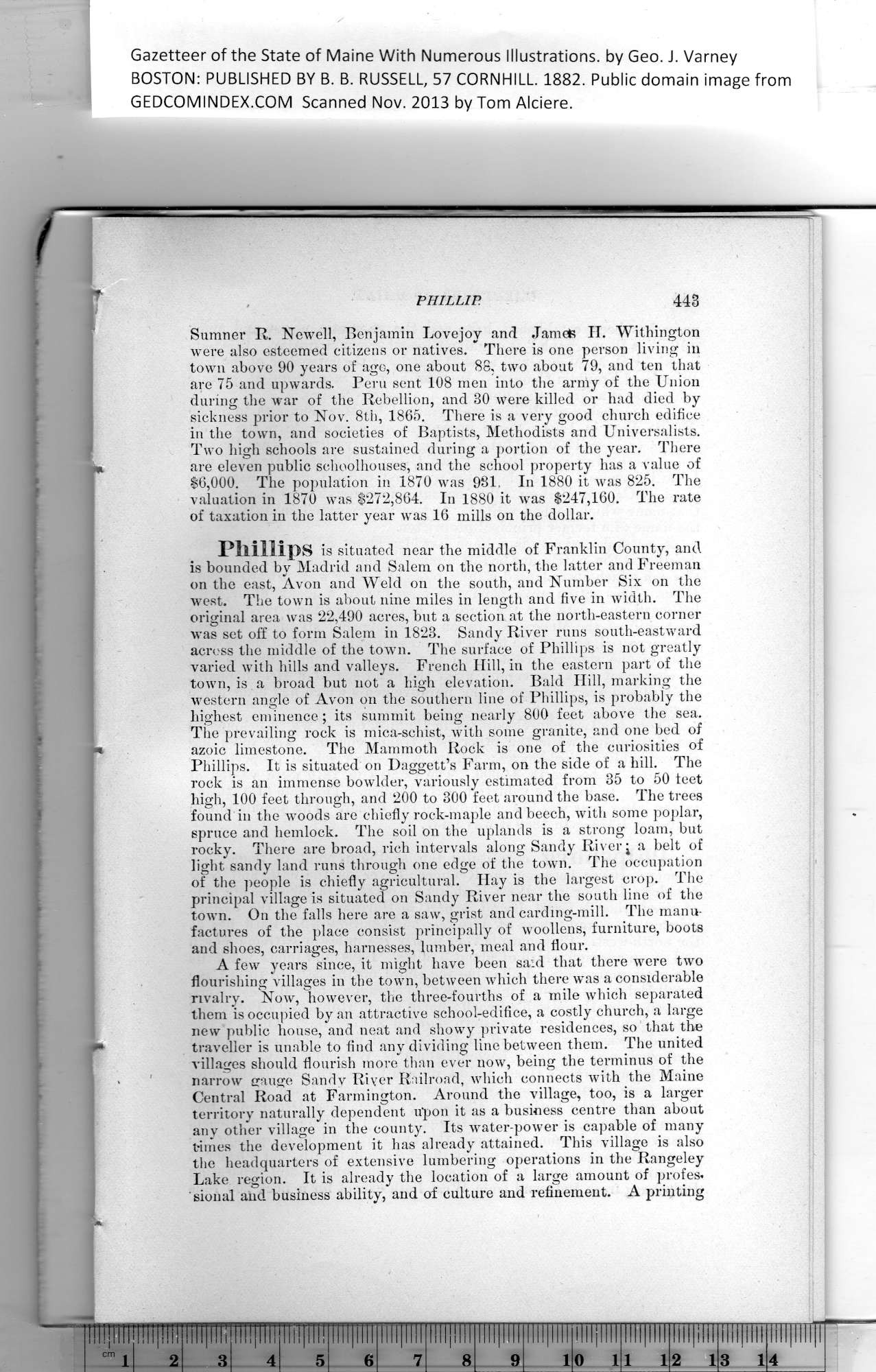|
Gazetteer of the State of Maine With Numerous Illustrations, by Geo. J. Varney
BOSTON: PUBLISHED BY B. B. RUSSELL, 57 CORNHILL. 1882. Public domain image from
r
PHILLIP. 443
Sumner R. Newell, Benjamin Lovejoy and Jamefc H. Withington
wrnre also esteemed citizens or natives. There is one person living in
town above 90 years of age, one about 88, two about 79, and ten that
are 75 and upwards. Peru sent 108 men into the army of the Union
during the war of the Rebellion, and 80 were killed or had died by
sickness prior to Nov. 8th, 1865. There is a very good church edifice
in the town, and societies of Baptists, Methodists and Universalists.
Two high schools are sustained during a portion of the year. There
are eleven public schoolhouses, and the school property has a value of
$6,000. The population in 1870 was 981, In 1880 it was 825. The
valuation in 1870 was $272,864. In 1880 it was $247,160. The rate
of taxation in the latter year was 16 mills on the dollar.
_ is situated near the middle of Franklin County, and
is bounded by Madrid and Salem on the north, the latter and Freeman
on the east, Avon and Weld on the south, and Number Six on the
west. The town is about nine miles in length and five in width. The
original area was 22,490 acres, but a section at the north-eastern corner
was set off to form Salem in 1823. Sandy River runs south-eastward
across the middle of the town. The surface of Phillips is not greatly
varied with hills and valleys. French Hill, in the eastern part of the
town, is a broad but not a high elevation. Bald Hill, marking the
western angle of Avon on the southern line of Phillips, is probably the
highest eminence; its summit being nearly 800 feet above the sea.
The prevailing rock is mica-schist, with some granite, and one bed of
azoic limestone. The Mammoth Rock is one of the curiosities of
Phillips. It is situated on Daggett’s Farm, on the side of a hill. The
rock is an immense bowdder, variously estimated from 35 to 50 teet
high, 100 feet through, and 200 to 300 feet around the base. The trees
found in the woods are chiefly rock-maple and beech, with some poplar,
spruce and hemlock. The soil on the uplands is a strong loam, but
rocky. There are broad, rich intervals along Sandy River ^ a belt of
light sandy land runs through one edge of the town. The occupation
of the people is chiefly agricultural. Hay is the largest crop. The
principal village is situated on Sandy River near the south line of the
town. On the falls here are a saw, grist and carding-mill. The manu-
factures of the place consist principally of woollens, furniture, boots
and shoes, carriages, harnesses, lumber, meal and flour.
A few years since, it might have been said that there were two
flourishing villages in the town, between which there was a considerable
rivalry. Now, however, the three-fourths of a mile which separated
them is occupied by an attractive school-edifice, a costly church, a large
new public house, and neat and showy private residences, so that the
traveller is unable to find any dividing line between them. The united
villages should flourish more than ever now, being the terminus of the
narrow gauge Sandy River Railroad, which connects with the Maine
Central Road at Farmington. Around the village, too, is a larger
territory naturally dependent upon it as a business centre than about
anv other village in the county. Its water-power is capable of rnauy
times the development it has already attained. This village is also
the headquarters of extensive lumbering operations in the Rangeley
Lake region. It is already the location of a large amount of profes.
sional and business ability, and of culture and refinement. A printing
PREVIOUS PAGE ... NEXT PAGE
This page was written in HTML using a program written in Python 3.2
|
